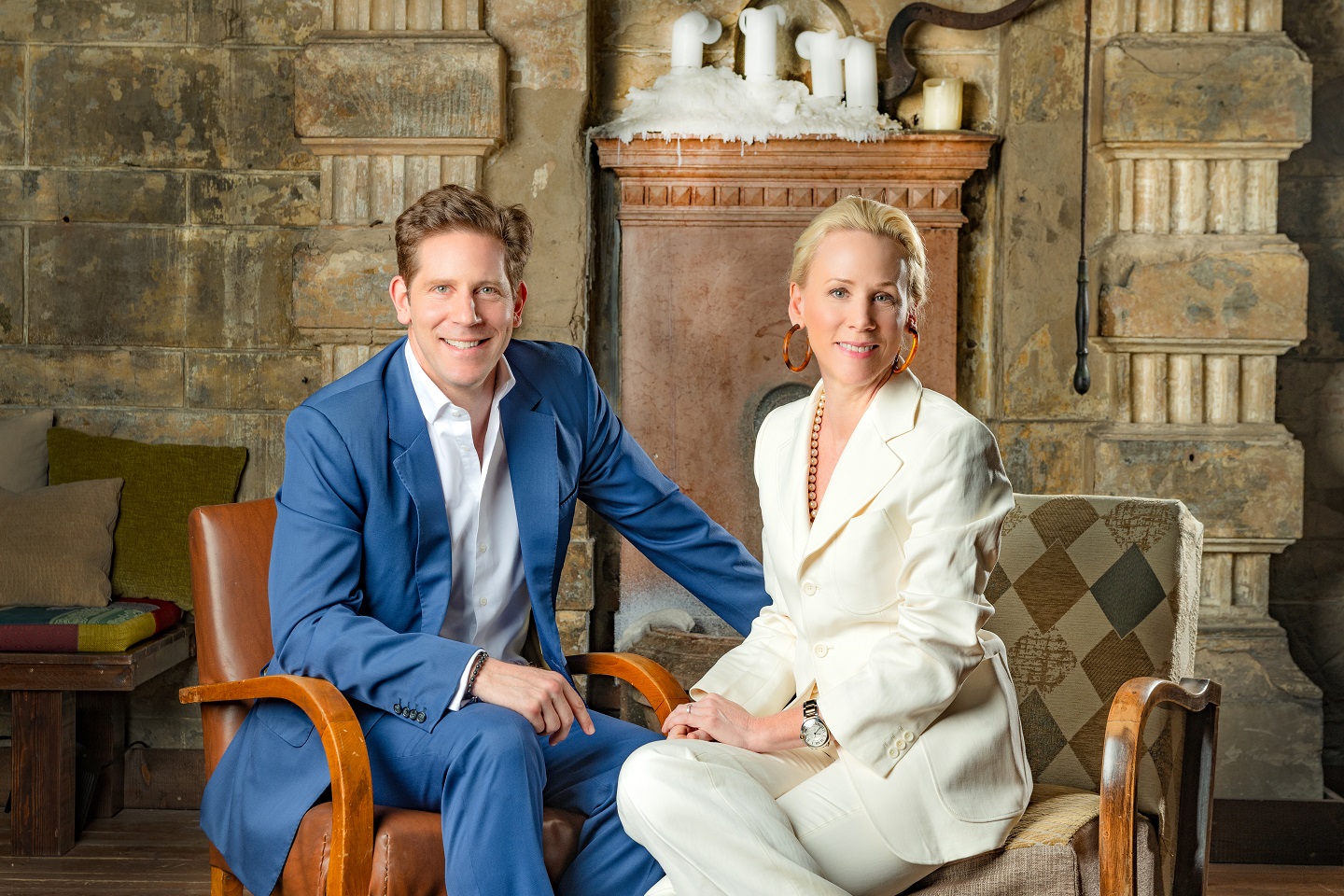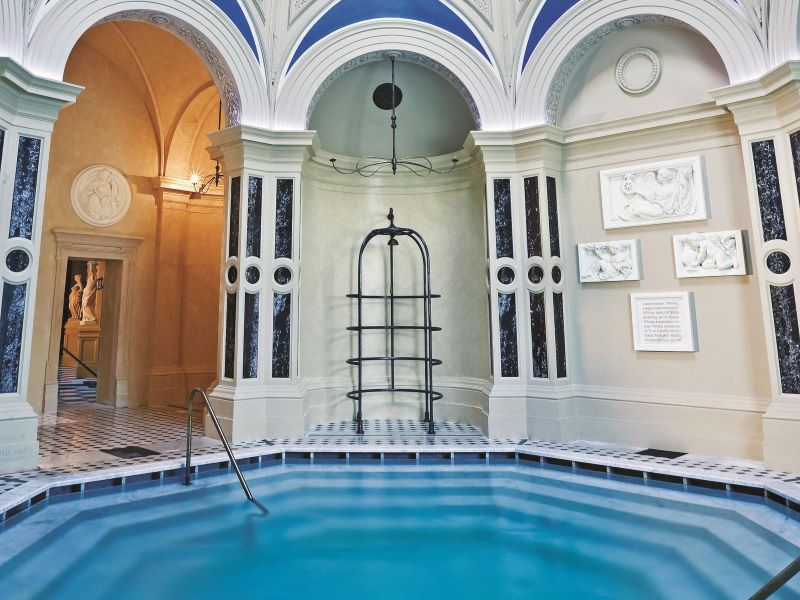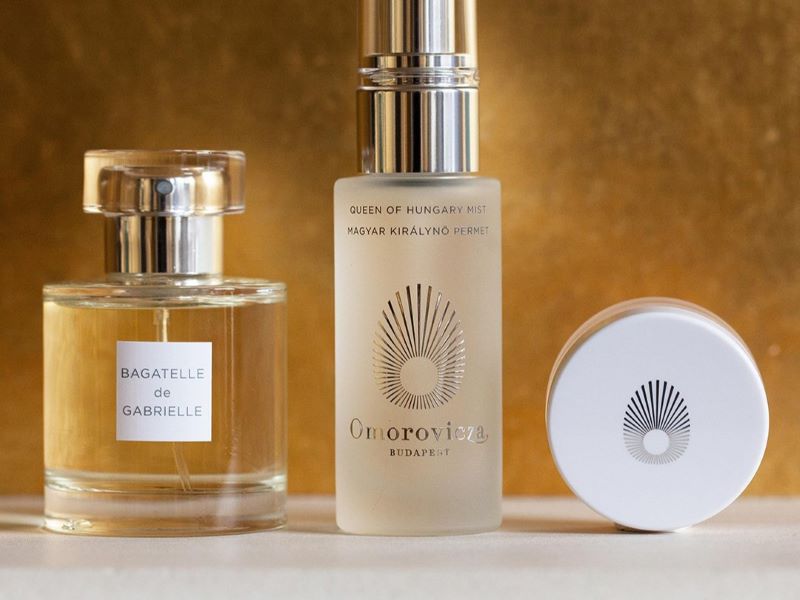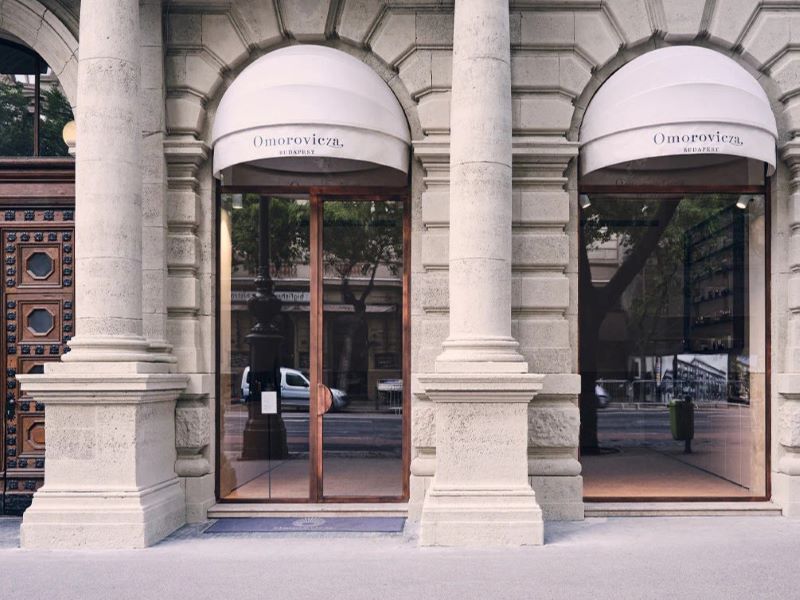
Founders of Omorovicza: Stephen and Margaret de Heinrich de Omorovicza. (Photo: Laszlo Zsigmond/Options)
If a relationship in its ideal form should be a meeting of minds and hearts, the crackling chemistry between husband and wife Stephen and Margaret de Heinrich de Omorovicza embodies it perfectly. During our photo shoot at the Bohemian multicultural hub, Brody Studios, in Budapest, the couple prefers to either sit or stand together — in a clear declaration of their vision of romance and business partnership based on mutual respect and equality. “Neither of us is more important than the other. We are in this together,” Stephen assures me.
The cult status of Omorovicza (pronounced “o-mor-o-veet-sa”) is built upon traditions and true serendipity; its success story a coincidence of fate, luck, hard work and Budapest’s rich lode of heritage. The Hungarian capital believes itself to be one of the places where the flame of Art Deco and Nouveau architecture burns the brightest; where its curative thermal bath sites — 125 in Budapest and almost 1,000 in the country — are as prized as the multitude of museums scattered across London or Paris. Teased by the promise of a rejuvenated body after a long flight, I took the plunge at the Neo-Baroque-style Széchenyi, the largest bath in Europe. For a calming 30 minutes, I briefly retired to a meditative state and disappeared into the magnitude of a 2,000-year-old ritual started by Roman emperor Marcus Aurelius.
The impetus for Omorovicza’s inception came from the incredibly poised, American-born Margaret (Dickerson), who arrives at our interview in a cream suit, accessorised only with a string of pearls that was gifted by Stephen after their first two children were born. She was fascinated by the vast healing properties of the thermal waters in Budapest when she moved there 17 years ago to become chief of staff to the then US Ambassador to Hungary, Nancy Brinker.
Her impressive CV, peppered with internships and work experience at TIME, W and Vogue, would make one think she was headed for publishing. However, enticed by the thought of living in an exotic country she had not been to, Margaret eventually found herself darting in and out of endless forums and secret meetings with heads of states, sometimes at the risk of breaking her stilettos on Budapest’s cobbled streets. As fate would have it, it turned out that Brinker not only introduced her to the mysticism of the city of spas but also to her future husband.
Margaret and the charming Swiss-Hungarian aristocrat Stephen de Heinrich de Omorovicza — who read history at Cambridge and practised law later — went for dinner. The spark was instantaneous. Eager to show her the world he came from, Stephen brought Margaret to a local spa, of course, and regaled her with the history of the Roman baths, the Knights Templar who built hospices on the side of the buildings to treat leprosy and the pashas who brought with them the hammam culture during the Ottoman occupation. Little did she know that the spa she went to, The Rácz, which dates back to the 16th century, belonged to Stephen’s family.
racz_spa_in_budapest.jpg

In the 1800s, one of his ancestors commissioned the country’s leading architect, Miklós Ybl, who achieved prominence for designing Budapest’s icons — such as the ornate Hungarian State Opera House and the imposing St Stephen’s Basilica — to build what would be touted as one of Europe’s earliest spas. Then, the Omorovicza family, which shares the same name as the town given by an Austro-Hungarian emperor for their philanthropy and engagement in the community, donated the Ottoman-domed bathhouse to benefit the people of Hungary. Stephen’s firm connection to his ancestry may have laid the foundations of Omorovicza in 2006 but it was the thermal waters’ soothing effect on Margaret’s troubled skin that launched a purpose: to produce a skincare range that harnesses the minerals from the Hungarian springs to restore one’s vim and vigour.
“There’s a lovely link, a thread from the past that predates us. I love things being in a continuum rather than having a starting and an ending, just like the ever-flowing thermal waters. We’re looking for people who have the propensity to fl y with the brand story. That’s the interesting thing about most great brands out there. They give you so much more than just products; they’re giving you a world for you to dive into,” says Stephen.
Omorovicza’s winning formula relies on science and the generosity of Mother Nature. Budapest is geologically strategic as the crust of the Earth here is thinner than anywhere else, so water absorbs beneficial minerals such as calcium, magnesium, copper and zinc more effectively on its way to the surface. Enlisting the expertise of the Nobel Prize-winning dermatology laboratory in Szeged that discovered vitamin C, the founders pioneered and patented the Hydro Mineral Transference, a lengthy bio-fermentation process that reconfigures the complex molecular structure of minerals to make them more bio-available so they can penetrate deep into the epidermis.
An exhaustive study on every thermal water source in Hungary revealed that Stephen’s family spa is brimming with these minerals. Employing the technology they developed, the founders managed to include at least 60% to 80% of the Healing Concentrate in their products with the exclusion of unnecessary synthetic ingredients that could clog pores or prevent absorption. While thermal water is Omorovicza’s core DNA, the brand has also tapped the detoxifying and purifying benefits of organic moor mud from Lake Héviz, an active thermal lake just outside Budapest, which renews itself naturally every 72 hours.
The beauty market is constantly enlivened by fancy skincare technology but consumers still have a stronger affinity for authentic brands with an illustrious back story because they are not just buying into a logo but also into a set of values. In a world that feels increasingly contrived, mediated, impersonal and staged with puffed-up life-enhancing promises, the inspiration and stories behind some of Omorovicza’s bestsellers — also those that Margaret evidently enjoys telling — sound refreshingly compelling.
“The health benefits of the moor mud, in our popular Thermal Cleansing Balm for example, were first realised by the Romans when the wounds of their injured horses healed at a significant rate when they journeyed through the mineral-rich mud. On the other hand, we also have our award-winning Queen of Hungary Mist, a toner inspired by the Queen of Hungary Water, the world’s first recorded perfume formulated for Queen Elisabeth of Hungary in the 14th century. She had the recipe written out in gold,” she says.
queen_of_hungary_mist.jpg

You would imagine a luxury skincare range so steeped in heritage — and fronted by a power couple that is knowledgeable, handsome and tenacious — to immediately score a global hit. But the notoriously competitive beauty world, commanded by big players with stronger brand authority and a highly demanding crowd, posed a mounting challenge. “Well, first of all, we have a brand name that is impossible to pronounce,” Stephen laughs. “There were a lot of rejections at first. We weren’t able to get some of the key retailers to see the light. Until today, there are still some people who refuse to meet us.”
That stumbling block, however, did not dampen their hopes. In fact, the brand’s unusual name radiated a certain individuality and opulence that immediately elicited interest from the beauty cognoscenti. After all, what better way to establish a unique identity than with your own name? In the intervening years, Omorovicza shone through the monotony of a sea of skincare competitors. Its pristine-white packaging embellished with a blue peacock fan emblem — a nod to femininity, nobility, grace, freedom and the motifs detailing Budapest’s architecture — populated the shelves of Britain’s luxury department chain Harvey Nichols, America’s Neiman Marcus and luxury hotels. Now, Malaysia’s KENS Apothecary, Tokyo’s Isetan, Korea’s Belport, Hong Kong’s Joyce and many other premium retailers in the region have also come to appreciate Omorovicza’s exoticism.
As we turn our attention to Asia, a discussion of the disparities between the Hungarian baths and ancient practice of Japanese onsen seems almost inevitable. Stephen enlightens me: “The difference is quite substantial. In Japan, people go to onsens for the ceremony, the mood and the ritual. But in Hungary, the doctors prescribe the baths as treatments. People go to the baths religiously because their medicinal properties can alleviate health problems, from pulmonary issues to rheumatism. Having said that, the Japanese immediately understood Omorovicza when we first started there. Their own interest in thermal bathing really helped.”
Margaret chimes in with her personal experience. “There’s a smattering of demographics at the Hungarian thermal baths: the young, the elderly, men and women. When I went to the baths on my own, I was always amazed by the number of people at the door even before it opened. I personally found the baths a little expensive. I was earning a diplomat’s salary but I also know how much the average Hungarian was taking home. I later realised that people could afford it because the Hungarian government writes prescriptions for them to go.”
Health and wellness are often intertwined with beauty in skincare. But beauty is a very fuzzy concept these days. The main premise of a beauty business is to sell the possibility of transformation, so customers are always seeking to look better, a little more perfect. Are we then subjecting ourselves to a narrow and obsolete definition of beauty? The question hangs in the air for a while before Stephen elaborates: “It does have to be a combination of how you feel about yourself and how you want to present yourself. You have to feel like you can look the best you can. But it doesn’t have to correspond to an objective criterion out there that doesn’t really exist.”
Margaret hesitates slightly at her husband’s reply; the fluid teamwork of answers between the couple comes to a temporary halt. “It’s interesting because we say that, and I personally think that, in the advent of social media and photo-editing filters, we’re not living that. It’s so dangerous and if anything, it’s regressive. As an individual, I want to look beautiful. But I think the real magic only happens when you exceed your own expectations.” An approving Stephen concurs. “People are creating a persona that doesn’t live up to their real selves. I think beauty is about behaving with the confidence you have while living, eating or even using your products right.”
Listening to their perception of the very concept that governs their business reveals their contrasting cultural backgrounds. A person’s exposure to beauty in Hungary is vastly different from, say, the US. “I was very beauty conscious at an early age, and my mother too. She’s very inspiring and has great taste, and I inherited some of her clothes, like a vintage Chanel bouclé jacket. But growing up, I had troubles with my skin and that affected how I felt about myself. The only option was to go to a dermatologist. I wasn’t told how to cleanse my skin. The idea of a facial? Forget it. In Budapest, however, very few teenagers visit a dermatologist. They go to a facialist, who would pass on valuable information and tips on managing skin in different weather and seasonality,” Margaret explains.
omo_outside.jpg

She is not exaggerating. Before our interview, I had a facial at the flagship Omorovicza Boutique & Spa on Andrássy Avenue, the very place the brand was born. A whiff of sweet orange blossom perfumed the minimalist treatment room; its hushed ambience eased me into a state of relaxation as I sank back on to a warm, plush pillow. “Dry” was how my therapist Sylvia described my sleep-deprived skin (she probably would have added “dull”, “clogged” and “unloved” if the lights had been any brighter). After a quick application of products that included the Deep Cleansing Mask, Omoressence and Instant Perfection Serum, Sylvia plumped up my skin with a unique Hungarian massage technique that had the rapid precision of a machine but with a gentle human touch. I left the sleek boutique feeling elevated and educated.
I find out from Stephen that he also uses the same perfume house that works with Chanel and Hermès in Grasse, in the south of France, which explains the alluring fragrance in Omorovicza’s products. If Omorovicza were a scent, Stephen expresses it as “light and sunny” and “the image of summer that reminds you of pleasant thoughts like a holiday or your grandfather shaving in the morning”. Both founders love basking in the sun when they need to detach themselves from work, whether it is out sailing in the Mediterranean sea or skiing in winter.
Couples who face tremendous demands — careers, incessant travelling, children — often scale down their activities. But the Omoroviczas scale up. You might expect two souls from different parts of the world to conceive of their ambitions differently but Stephen and Margaret’s goals are very much aligned, be it their priorities, their pertinacious approach to business or the way they want to raise their four children. Their unyielding devotion to their careers may also be due to the fact that Budapest, which is inextricably linked to their past and future, has a reservoir of stories waiting to be told.
Stephen, who was born in Switzerland, recalls why he returned to Hungary: “I had heard so many wonderful and glamorous stories about Budapest before the war from my family. As a teenager, you start questioning things. I told my grandmother, ‘I think you’re making these things up. Take me there and show me’. So we took a boat from Vienna and arrived in Budapest at the end of the communist occupation in 1988. We hosted a non-stop cocktail party for six weeks and it gave me a privileged insight into this world that no one can have today because the people we met, who were born in the 1910s and 1920s, are dead. These are people of a certain background, who spoke a mixture of English, French and German. Budapest in the 1920s and 1930s was something else. I completely fell in love with that Budapest.”
A longstanding heritage like Omorovicza’s adds a certain gravitas to a brand but it takes good storytelling, vision and persistence to build strong luxury integrity. Stephen has the habit of writing quotes in his notebook, which serve as a balm and reminder of the values he holds dear. He shares with me one of his favourite lines in L’invitation au voyage by French poet Charles Baudelaire, who described a place cocooned in time, space and wonder: Là, tout n’est qu’ordre et beauté, Luxe, calme, et volupté, which loosely translates as, “There, all is in order and beauty; luxury, calm and pleasure”.
I thank Stephen and Margaret and step out into the summer heat, my curiosity about Budapest and the beauty world quenched.
This article first appeared on May 28, 2018 in The Edge Malaysia.


